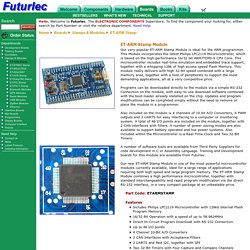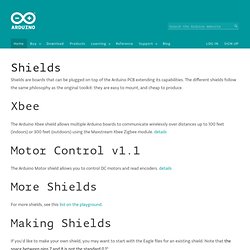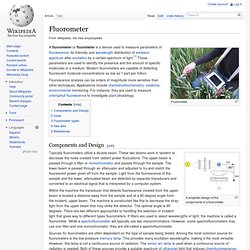

ramesh reddy
ET-ARM Stamp. Our very popular ET-ARM Stamp Module is ideal for the ARM programmer.

This Module incorporates the latest Philips LPC2119 Micorocontroller, which is based on the high-performance 16/32 bit ARM7TDMI-S CPU Core. This microcontroller includes real-time emulation and embedded trace support, together with a whopping 128k of high access speed Flash Memory. This module really delivers with high 32-bit speed combined with a large memory area, together with a host of peripherals to support the most demanding applications, all at a very competitive price.
Programs can be downloaded directly to the module via a simple RS-232 Connection on the module, with easy-to use download software combined with the boot-loader already installed on the chip. Updates and program modifications can be completed simply without the need to remove or place the module in a programmer. A number of software tools are available from Third Party Suppliers for code development in C or Assembly Language.
Features. WebHome < Main < Foswiki. ConnectCore Wi-i.MX51. The network-enabled ConnectCore Wi-i.MX51 is a highly integrated and future-proof system-on-module (SoM) solution based on the Freescale i.MX51 application processor with a high performance 600/800 MHz ARM Cortex-A8 core, powerful multimedia capabilities and a complete set of peripherals. It is the ideal choice for a broad range of target markets/applications including medical, digital signage, security/surveillance, access control, retail, industrial/building automation, transportation, traffic control, utilities/energy and more. Modules in the ConnectCore i.MX family feature the design, development and administrative advantages offered by Device Cloud by Etherios™.
This secure, highly-scalable platform seamlessly ties enterprise applications and remote devices together. Device Cloud empowers IT, network operations and customer support organizations to conquer the challenges of managing equipment in their device networks. Featured Models/Part Numbers. ARM - EmbDev.net. ARM CHIPS. Parallel Port Controller Using MATLAB. Guide provides a set of tools for creating graphical user interfaces (GUIs).

Just type ‘Guide’ against the prompt in Matlab command window. Select ‘Blank GUI’ option in the next window to launch Guide. Using ‘Layout’ editor option from Guide, you can populate a GUI by clicking and dragging GUI components—such as axes, panels, buttons, text fields, sliders and so on—into the layout area. ArduinoShields. Shields are boards that can be plugged on top of the Arduino PCB extending its capabilities.

The different shields follow the same philosophy as the original toolkit: they are easy to mount, and cheap to produce. Xbee The Arduino Xbee shield allows multiple Arduino boards to communicate wirelessly over distances up to 100 feet (indoors) or 300 feet (outdoors) using the Maxstream Xbee Zigbee module. details Motor Control v1.1 The Arduino Motor shield allows you to control DC motors and read encoders. details.
Pages Matching "line follower sensors" Arduino Tutorial - Lesson 4 - Serial communication and playing with data. Ah, Arduino, I remember when you were just crawling around and blinking LEDs.

Now you're ready to learn how to speak! In this lesson we'll learn how to use the Serial Library to communicate from the Arduino board back to the computer over the USB port. Then we'll learn how to manipulate numbers and data. For this lesson we won't be using the shield, so simply remove it (keeping the mood light LEDs on it you'd like).
The shield doesn't contain any programs or data, it is just our way of connecing up the LEDs and resistors. Libraries are great places, and not yet illegal in the United States! Software Libraries are very similar. The library we will be using is the Serial Library, which allows the Arduino to send data back to the computer: Mouser Electronics, Inc. E-Health Sensor Platform for Arduino and Raspberry Pi [Biometric / Medical Applications] This information can be used to monitor in real time the state of a patient or to get sensitive data in order to be subsequently analysed for medical diagnosis.
![e-Health Sensor Platform for Arduino and Raspberry Pi [Biometric / Medical Applications]](http://cdn.pearltrees.com/s/pic/th/raspberry-applications-125034638)
Biometric information gathered can be wirelessly sent using any of the 6 connectivity options available: Wi-Fi, 3G, GPRS, Bluetooth, 802.15.4 and ZigBee depending on the application. If real time image diagnosis is needed a camera can be attached to the 3G module in order to send photos and videos of the patient to a medical diagnosis center. Data can be sent to the Cloud in order to perform permanent storage or visualized in real time by sending the data directly to a laptop or Smartphone. iPhone and Android applications have been designed in order to easily see the patient's information. GATE 2013 (Graduate Aptitude Test in Engineering) Notification.
Fluorometer. Fluorometer A fluorometer or fluorimeter is a device used to measure parameters of fluorescence: its intensity and wavelength distribution of emission spectrum after excitation by a certain spectrum of light.[1] These parameters are used to identify the presence and the amount of specific molecules in a medium.

Modern fluorometers are capable of detecting fluorescent molecule concentrations as low as 1 part per trillion. Fluorescence analysis can be orders of magnitude more sensitive than other techniques. Applications include chemistry/biochemistry, medicine, environmental monitoring. Motor. Math numbers. Interactive Whiteboard Resources: Maths, Key Stage 2 - Topmarks Education.
Caterpillar OrderingTablet friendly A flexible game for ordering numbers and for number sequences.

Fantastic on an interactive whiteboard and tablet friendly. Varying levels of difficulty make it suitable for use throughout the primary age range. BEAM Heads 101. First let's examine how the HLO operates, without using the IN signal, behaving like a classic CMOS astable oscillator.

The oscillator consists of 2 inverters with the input of inverter A serving as a summing node for several signals. As can be seen, a 5M potentiometer (R1) is connected from the output of inverter A back to it's own input. Because of the signal inversion, this is DC negative feedback, which tends to drive the input voltage of inverter A towards its 1/2V+ threshold. The output of inverter A is also directly connected to the input of inverter B. The output of inverter B is connected with a capacitor back to the input of inverter A.
Getting started. Without a Trace: Turn Your Flash Drive into a Portable Privacy Toolkit. Top 100 Network Security Tools. Computer-hardware-2.jpg (JPEG Image, 1280x1813 pixels) - Scaled (35%)